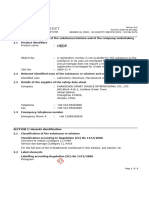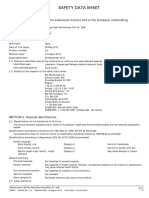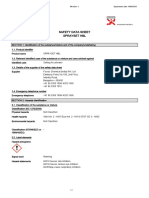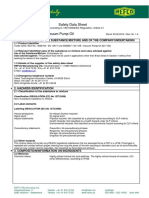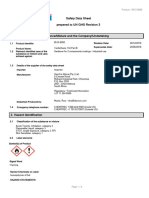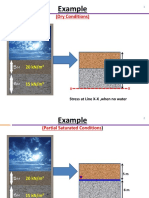Safety Data Sheet: SECTION 1: Identification of The Substance/mixture and of The Company/undertaking
Safety Data Sheet: SECTION 1: Identification of The Substance/mixture and of The Company/undertaking
Uploaded by
dkjksdhfusdCopyright:
Available Formats
Safety Data Sheet: SECTION 1: Identification of The Substance/mixture and of The Company/undertaking
Safety Data Sheet: SECTION 1: Identification of The Substance/mixture and of The Company/undertaking
Uploaded by
dkjksdhfusdOriginal Title
Copyright
Available Formats
Share this document
Did you find this document useful?
Is this content inappropriate?
Copyright:
Available Formats
Safety Data Sheet: SECTION 1: Identification of The Substance/mixture and of The Company/undertaking
Safety Data Sheet: SECTION 1: Identification of The Substance/mixture and of The Company/undertaking
Uploaded by
dkjksdhfusdCopyright:
Available Formats
SAFETY DATA SHEET
SECTION 1: Identification of the substance/mixture and of the company/undertaking
1.1. Product identifier
Trade name or designation Borchi® Gel PN
of the mixture
Registration number -
Synonyms None.
Issue date 09-December-2015
Version number 05
Revision date 28-February-2020
Supersedes date 24-June-2019
1.2. Relevant identified uses of the substance or mixture and uses advised against
Identified uses Additive
Uses advised against None known.
1.3. Details of the supplier of the safety data sheet
Supplier
Company name Borchers sas
Address 1 rue Albert Calmette
FR-81100 Castres
Division
Telephone +33 (0)5 63 72 65 70
Telefax Number +33 (0)5 63 59 70 06
e-mail SDS@borchers.com
Contact person Not available.
1.4. Emergency telephone Chemtrec INTL +1 703 527 3887
number
USA +1 800 424 9300
SECTION 2: Hazards identification
2.1. Classification of the substance or mixture
The mixture has been assessed and/or tested for its physical, health and environmental hazards and the following classification
applies.
Classification according to Regulation (EC) No 1272/2008 as amended
Health hazards
Acute toxicity, oral Category 4 H302 - Harmful if swallowed.
Hazard summary Harmful if swallowed.
2.2. Label elements
Label according to Regulation (EC) No. 1272/2008 as amended
Contains: Zirconium, acetate lactate oxo ammonium complexes
Hazard pictograms
Signal word Warning
Hazard statements
H302 Harmful if swallowed.
Precautionary statements
Prevention
P264 Wash thoroughly after handling.
P270 Do not eat, drink or smoke when using this product.
Response
P301 + P312 IF SWALLOWED: Call a POISON CENTRE/doctor if you feel unwell.
P330 Rinse mouth.
Material name: Borchi® Gel PN SDS EU
1115 Version #: 05 Revision date: 28-February-2020 Issue date: 09-December-2015 1/6
Storage Store away from incompatible materials.
Disposal
P501 Dispose of contents/container in accordance with local/regional/national/international regulations.
Supplemental label information None.
2.3. Other hazards Not a PBT or vPvB substance or mixture.
SECTION 3: Composition/information on ingredients
3.2. Mixtures
General information
Chemical name % CAS-No. / EC No. REACH Registration No. Index No. Notes
Zirconium, acetate lactate oxo 40-50 68909-34-2 01-2120786881-39 -
ammonium complexes 272-702-7
Classification: Acute Tox. 4;H302
List of abbreviations and symbols that may be used above
#: This substance has been assigned Union workplace exposure limit(s).
M: M-factor
PBT: persistent, bioaccumulative and toxic substance.
vPvB: very persistent and very bioaccumulative substance.
All concentrations are in percent by weight unless ingredient is a gas. Gas concentrations are in percent by volume.
Composition comments The full text for all H-statements is displayed in section 16.
SECTION 4: First aid measures
General information Ensure that medical personnel are aware of the material(s) involved, and take precautions to
protect themselves. Show this safety data sheet to the doctor in attendance.
4.1. Description of first aid measures
Inhalation Move to fresh air. Call a physician if symptoms develop or persist.
Skin contact Wash off with soap and water. Get medical attention if irritation develops and persists.
Eye contact Rinse with water. Get medical attention if irritation develops and persists.
Ingestion Rinse mouth. If vomiting occurs, keep head low so that stomach content doesn't get into the lungs.
Get medical advice/attention if you feel unwell.
4.2. Most important symptoms Exposure may cause temporary irritation, redness, or discomfort.
and effects, both acute and
delayed
4.3. Indication of any Provide general supportive measures and treat symptomatically. Keep victim warm. Keep victim
immediate medical attention under observation. Symptoms may be delayed.
and special treatment needed
SECTION 5: Firefighting measures
General fire hazards No unusual fire or explosion hazards noted.
5.1. Extinguishing media
Suitable extinguishing Water fog. Foam. Dry chemical powder. Carbon dioxide (CO2).
media
Unsuitable extinguishing Do not use water jet as an extinguisher, as this will spread the fire.
media
5.2. Special hazards arising During fire, gases hazardous to health may be formed.
from the substance or mixture
5.3. Advice for firefighters
Special protective Self-contained breathing apparatus and full protective clothing must be worn in case of fire.
equipment for firefighters
Special fire fighting Move containers from fire area if you can do so without risk.
procedures
Specific methods Use standard firefighting procedures and consider the hazards of other involved materials.
SECTION 6: Accidental release measures
6.1. Personal precautions, protective equipment and emergency procedures
For non-emergency Keep unnecessary personnel away. Keep people away from and upwind of spill/leak. Wear
personnel appropriate protective equipment and clothing during clean-up. Ensure adequate ventilation. Local
authorities should be advised if significant spillages cannot be contained. For personal protection,
see section 8 of the SDS.
For emergency responders Keep unnecessary personnel away. Use personal protection recommended in Section 8 of the
SDS.
6.2. Environmental precautions Avoid discharge into drains, water courses or onto the ground.
Material name: Borchi® Gel PN SDS EU
1115 Version #: 05 Revision date: 28-February-2020 Issue date: 09-December-2015 2/6
6.3. Methods and material for This product is miscible in water.
containment and cleaning up
Large Spills: Stop the flow of material, if this is without risk. Dike the spilled material, where this is
possible. Absorb in vermiculite, dry sand or earth and place into containers. Following product
recovery, flush area with water.
Small Spills: Wipe up with absorbent material (e.g. cloth, fleece). Clean surface thoroughly to
remove residual contamination.
Never return spills to original containers for re-use.
6.4. Reference to other For personal protection, see section 8 of the SDS. For waste disposal, see section 13 of the SDS.
sections
SECTION 7: Handling and storage
7.1. Precautions for safe Do not taste or swallow. When using, do not eat, drink or smoke. Provide adequate ventilation.
handling Wear appropriate personal protective equipment. Wash hands thoroughly after handling. Observe
good industrial hygiene practices.
7.2. Conditions for safe Store in tightly closed container. Store away from incompatible materials (see Section 10 of the
storage, including any SDS).
incompatibilities
7.3. Specific end use(s) Not available.
SECTION 8: Exposure controls/personal protection
8.1. Control parameters
Occupational exposure limits No exposure limits noted for ingredient(s).
Biological limit values No biological exposure limits noted for the ingredient(s).
Recommended monitoring Follow standard monitoring procedures.
procedures
Derived no effect levels Not available.
(DNELs)
Predicted no effect Not available.
concentrations (PNECs)
8.2. Exposure controls
Appropriate engineering Good general ventilation should be used. Ventilation rates should be matched to conditions. If
controls applicable, use process enclosures, local exhaust ventilation, or other engineering controls to
maintain airborne levels below recommended exposure limits. If exposure limits have not been
established, maintain airborne levels to an acceptable level.
Individual protection measures, such as personal protective equipment
General information Personal protection equipment should be chosen according to the CEN standards and in
discussion with the supplier of the personal protective equipment.
Eye/face protection Face shield is recommended. Wear safety glasses with side shields (or goggles).
Skin protection
- Hand protection Use protective gloves made of: Nitrile. Polyvinyl chloride (PVC).
- Other Wear suitable protective clothing.
Respiratory protection In case of insufficient ventilation, wear suitable respiratory equipment.
Thermal hazards Wear appropriate thermal protective clothing, when necessary.
Hygiene measures Keep away from food and drink. Always observe good personal hygiene measures, such as
washing after handling the material and before eating, drinking, and/or smoking. Routinely wash
work clothing and protective equipment to remove contaminants.
Environmental exposure Good general ventilation should be used. Ventilation rates should be matched to conditions. If
controls applicable, use process enclosures, local exhaust ventilation, or other engineering controls to
maintain airborne levels below recommended exposure limits. If exposure limits have not been
established, maintain airborne levels to an acceptable level.
SECTION 9: Physical and chemical properties
9.1. Information on basic physical and chemical properties
Appearance
Physical state Liquid.
Form Liquid.
Colour Yellow
Odour Ammoniacal.
Odour threshold Not available.
Material name: Borchi® Gel PN SDS EU
1115 Version #: 05 Revision date: 28-February-2020 Issue date: 09-December-2015 3/6
pH 9 Product
Melting point/freezing point Not available.
Initial boiling point and boiling > 100 °C (> 212 °F) (Water)
range
Flash point Not available.
Evaporation rate Not available.
Flammability (solid, gas) Not applicable.
Upper/lower flammability or explosive limits
Flammability limit - lower Not available.
(%)
Flammability limit - upper Not available.
(%)
Vapour pressure Not available.
Vapour density Not available.
Relative density Not available.
Solubility(ies)
Solubility (water) Soluble
Partition coefficient Not available.
(n-octanol/water)
Auto-ignition temperature Not available.
Decomposition temperature Not available.
Viscosity Not available.
Explosive properties Not explosive.
Oxidising properties Not oxidising.
9.2. Other information
Density 1,23 g/cm³ (20°C)
Kinematic viscosity > 20,5 mm²/s
Kinematic viscosity 40 °C (104 °F)
temperature
SECTION 10: Stability and reactivity
10.1. Reactivity The product is stable and non-reactive under normal conditions of use, storage and transport.
10.2. Chemical stability Material is stable under normal conditions.
10.3. Possibility of hazardous No dangerous reaction known under conditions of normal use.
reactions
10.4. Conditions to avoid Keep away from heat, hot surfaces, sparks, open flames and other ignition sources. Contact with
incompatible materials.
10.5. Incompatible materials Strong oxidising agents.
10.6. Hazardous No hazardous decomposition products are known.
decomposition products
SECTION 11: Toxicological information
General information Occupational exposure to the substance or mixture may cause adverse effects.
Information on likely routes of exposure
Inhalation No adverse effects due to inhalation are expected.
Skin contact No adverse effects due to skin contact are expected.
Eye contact Direct contact with eyes may cause temporary irritation.
Ingestion Harmful if swallowed.
Symptoms Exposure may cause temporary irritation, redness, or discomfort.
11.1. Information on toxicological effects
Acute toxicity Harmful if swallowed.
Components Species Test Results
Zirconium, acetate lactate oxo ammonium complexes (CAS 68909-34-2)
Acute
Oral
LD50 Rat 500 mg/kg
Material name: Borchi® Gel PN SDS EU
1115 Version #: 05 Revision date: 28-February-2020 Issue date: 09-December-2015 4/6
Skin corrosion/irritation Based on available data, the classification criteria are not met.
Serious eye damage/eye Based on available data, the classification criteria are not met.
irritation
Respiratory sensitisation Due to partial or complete lack of data the classification is not possible.
Skin sensitisation Due to partial or complete lack of data the classification is not possible.
Germ cell mutagenicity Due to partial or complete lack of data the classification is not possible.
Carcinogenicity Due to partial or complete lack of data the classification is not possible.
Hungary. 26/2000 EüM Ordinance on protection against and preventing risk relating to exposure to carcinogens at work
(as amended)
Not listed.
Reproductive toxicity Due to partial or complete lack of data the classification is not possible.
Specific target organ toxicity - Due to partial or complete lack of data the classification is not possible.
single exposure
Specific target organ toxicity - Due to partial or complete lack of data the classification is not possible.
repeated exposure
Aspiration hazard Due to partial or complete lack of data the classification is not possible.
Mixture versus substance No information available.
information
Other information Not available.
SECTION 12: Ecological information
12.1. Toxicity Based on available data, the classification criteria are not met for hazardous to the aquatic
environment.
12.2. Persistence and No data is available on the degradability of any ingredients in the mixture.
degradability
12.3. Bioaccumulative potential No data available.
Partition coefficient Not available.
n-octanol/water (log Kow)
Bioconcentration factor (BCF) Not available.
12.4. Mobility in soil No data available.
12.5. Results of PBT and vPvB Not a PBT or vPvB substance or mixture.
assessment
12.6. Other adverse effects No other adverse environmental effects (e.g. ozone depletion, photochemical ozone creation
potential, endocrine disruption, global warming potential) are expected from this component.
SECTION 13: Disposal considerations
13.1. Waste treatment methods
Residual waste Dispose of in accordance with local regulations. Empty containers or liners may retain some
product residues. This material and its container must be disposed of in a safe manner (see:
Disposal instructions).
Contaminated packaging Since emptied containers may retain product residue, follow label warnings even after container is
emptied. Empty containers should be taken to an approved waste handling site for recycling or
disposal.
EU waste code The Waste code should be assigned in discussion between the user, the producer and the waste
disposal company.
Disposal methods/information Collect and reclaim or dispose in sealed containers at licensed waste disposal site. Dispose of
contents/container in accordance with local/regional/national/international regulations.
Special precautions Dispose in accordance with all applicable regulations.
SECTION 14: Transport information
ADR
Not regulated as dangerous goods.
IATA
14.1. - 14.6.: Not regulated as dangerous goods.
IMDG
Not regulated as dangerous goods.
14.7. Transport in bulk Not established.
according to Annex II of
MARPOL 73/78 and the IBC
Code
Material name: Borchi® Gel PN SDS EU
1115 Version #: 05 Revision date: 28-February-2020 Issue date: 09-December-2015 5/6
SECTION 15: Regulatory information
15.1. Safety, health and environmental regulations/legislation specific for the substance or mixture
EU regulations
Regulation (EC) No. 1005/2009 on substances that deplete the ozone layer, Annex I and II, as amended
Not listed.
Regulation (EC) No. 850/2004 On persistent organic pollutants, Annex I as amended
Not listed.
Regulation (EU) No. 649/2012 concerning the export and import of dangerous chemicals, Annex I, Part 1 as amended
Not listed.
Regulation (EU) No. 649/2012 concerning the export and import of dangerous chemicals, Annex I, Part 2 as amended
Not listed.
Regulation (EU) No. 649/2012 concerning the export and import of dangerous chemicals, Annex I, Part 3 as amended
Not listed.
Regulation (EU) No. 649/2012 concerning the export and import of dangerous chemicals, Annex V as amended
Not listed.
Regulation (EC) No. 166/2006 Annex II Pollutant Release and Transfer Registry, as amended
Not listed.
Regulation (EC) No. 1907/2006, REACH Article 59(10) Candidate List as currently published by ECHA
Not listed.
Authorisations
Regulation (EC) No. 1907/2006, REACH Annex XIV Substances subject to authorization, as amended
Not listed.
Restrictions on use
Regulation (EC) No. 1907/2006, REACH Annex XVII Substances subject to restriction on marketing and use as amended
Not listed.
Directive 2004/37/EC: on the protection of workers from the risks related to exposure to carcinogens and mutagens at
work, as amended.
Not listed.
Other EU regulations
Directive 2012/18/EU on major accident hazards involving dangerous substances, as amended
Not listed.
Other regulations The product is classified and labelled in accordance with Regulation (EC) 1272/2008 (CLP
Regulation) as amended. This Safety Data Sheet complies with the requirements of Regulation
(EC) No 1907/2006, as amended.
National regulations Follow national regulation for work with chemical agents in accordance with Directive 98/24/EC, as
amended.
Water hazard class
AwSV WGK2
15.2. Chemical safety No Chemical Safety Assessment has been carried out.
assessment
SECTION 16: Other information
List of abbreviations Not available.
References Not available.
Information on evaluation The classification for health and environmental hazards is derived by a combination of calculation
method leading to the methods and test data, if available.
classification of mixture
Full text of any H-statements H302 Harmful if swallowed.
not written out in full under
Sections 2 to 15
Revision information None.
Training information Follow training instructions when handling this material.
Disclaimer Borchers sas cannot anticipate all conditions under which this information and its product, or the
products of other manufacturers in combination with its product, may be used. It is the user’s
responsibility to ensure safe conditions for handling, storage and disposal of the product, and to
assume liability for loss, injury, damage or expense due to improper use. The information in the
sheet was written based on the best knowledge and experience currently available.
Material name: Borchi® Gel PN SDS EU
1115 Version #: 05 Revision date: 28-February-2020 Issue date: 09-December-2015 6/6
You might also like
- Chapter 10-Decision-Making in SchoolDocument18 pagesChapter 10-Decision-Making in Schoolcherie0% (1)
- Gamsol SDS EU English March 2021Document8 pagesGamsol SDS EU English March 2021micaNo ratings yet
- MSDS TSHDocument8 pagesMSDS TSHdwiNo ratings yet
- Safety Data Sheet: SECTION 1: Identification of The Substance/mixture and of The Company/undertakingDocument10 pagesSafety Data Sheet: SECTION 1: Identification of The Substance/mixture and of The Company/undertakinglxd.hepNo ratings yet
- Safety Data Sheet: SECTION 1: Identification of The Substance/mixture and of The Company/undertakingDocument8 pagesSafety Data Sheet: SECTION 1: Identification of The Substance/mixture and of The Company/undertakingdkjksdhfusdNo ratings yet
- Borax Anhydrous CAS No 1330-43-4: Material Safety Data Sheet Sds/MsdsDocument7 pagesBorax Anhydrous CAS No 1330-43-4: Material Safety Data Sheet Sds/MsdsLeo PalNo ratings yet
- HP Imaging OilDocument9 pagesHP Imaging Oilshortvideo3434No ratings yet
- LAGERMEISTER - TS - SD - CP1000063 - GB - EN GreaseDocument10 pagesLAGERMEISTER - TS - SD - CP1000063 - GB - EN GreaseNideeshNo ratings yet
- MSDS - Europe Vidas FT4N 30459Document7 pagesMSDS - Europe Vidas FT4N 30459Jermain BarbadosNo ratings yet
- LC 25940Document6 pagesLC 25940Putri AlyaNo ratings yet
- MSDS Sodium CyanideDocument8 pagesMSDS Sodium CyanideLve LviNo ratings yet
- MSDS of HEDPDocument8 pagesMSDS of HEDPalvin07158No ratings yet
- SDS of Tartaric AcidDocument6 pagesSDS of Tartaric AcidWici WiciNo ratings yet
- LPKF Cleaner 210 v2.2Document8 pagesLPKF Cleaner 210 v2.2amber jonesNo ratings yet
- MSDS T3Document7 pagesMSDS T3dwi100% (1)
- MSDS of 1,2,4-TrichlorobenzeneDocument10 pagesMSDS of 1,2,4-Trichlorobenzenealvin07158No ratings yet
- 37_364415965_o-TOLIDINEHYDROCHLORIDECASNO612-82-8MSDSDocument7 pages37_364415965_o-TOLIDINEHYDROCHLORIDECASNO612-82-8MSDSMuhamad RamdhanNo ratings yet
- HDS - AviPro MG FDocument12 pagesHDS - AviPro MG Fsuarez.yaselga.cinthia.96No ratings yet
- Fuchs Titan Race Pro S 5w 40Document10 pagesFuchs Titan Race Pro S 5w 40Yasin YañezNo ratings yet
- McCULLOH Öl PDFDocument6 pagesMcCULLOH Öl PDFkai iolaNo ratings yet
- Na OHDocument7 pagesNa OHMaria BarretoNo ratings yet
- Potassium Hydrogen Phthalate: Safety Data SheetDocument6 pagesPotassium Hydrogen Phthalate: Safety Data SheetdeleonmatthewreiNo ratings yet
- Sds Renolin B 3 VG 10Document10 pagesSds Renolin B 3 VG 10kiranNo ratings yet
- TDS M162Document8 pagesTDS M162darrendelfinoy9No ratings yet
- 000534hy-Cn CGHS enDocument15 pages000534hy-Cn CGHS enEdgar Giovanni Vidal BarriosNo ratings yet
- Phenolphthalein (IndicatorSolution) MSDSDocument7 pagesPhenolphthalein (IndicatorSolution) MSDSsujith reddyNo ratings yet
- GRM8535Document7 pagesGRM8535John ZoidbergNo ratings yet
- KBR-01 MSDS (Eng)Document8 pagesKBR-01 MSDS (Eng)Mahmood Anwar ShadNo ratings yet
- Sodium Tetraborate, Decahydrate: Safety Data SheetDocument6 pagesSodium Tetraborate, Decahydrate: Safety Data SheetAnnisa MardhatillahNo ratings yet
- Safety Data Sheet: SECTION 1: Identification of The Substance/mixture and of The Company/undertakingDocument12 pagesSafety Data Sheet: SECTION 1: Identification of The Substance/mixture and of The Company/undertakinglxd.hepNo ratings yet
- SW BAW04-42 Coolant OilDocument8 pagesSW BAW04-42 Coolant OilZsoltiNo ratings yet
- Bel Ray High Performance Fork Oil 20w Item 99340 Eu English MsdsDocument9 pagesBel Ray High Performance Fork Oil 20w Item 99340 Eu English MsdswilliamsNo ratings yet
- Toprinse JetDocument10 pagesToprinse JetValer valentineNo ratings yet
- Safety Data Sheet Prepared To UN GHS Revision 3: Date Printed: 25/06/2018 Product: 520 CLEARDocument8 pagesSafety Data Sheet Prepared To UN GHS Revision 3: Date Printed: 25/06/2018 Product: 520 CLEARKOKOLENo ratings yet
- Safety Data Sheet: 4-Bromo-1-Butylboronic Acid Catechol EsterDocument8 pagesSafety Data Sheet: 4-Bromo-1-Butylboronic Acid Catechol EsterHesham AlsoghierNo ratings yet
- Titan Saf 5045 Eu137redDocument10 pagesTitan Saf 5045 Eu137redJOSUE GUTIERREZNo ratings yet
- Safety Data Sheet: SECTION 1: Identification of The Substance/mixture and of The Company/undertakingDocument7 pagesSafety Data Sheet: SECTION 1: Identification of The Substance/mixture and of The Company/undertakingKadek Ayang Cendana PrahayuNo ratings yet
- Msds Tugas Bu AisyDocument7 pagesMsds Tugas Bu AisyB. R. Y SAMNo ratings yet
- LGFP2 enDocument6 pagesLGFP2 enMunkhnasan MonaNo ratings yet
- MSDS 1-Bromooctane (Sigma Aldrich)Document8 pagesMSDS 1-Bromooctane (Sigma Aldrich)David SonyNo ratings yet
- Sodium Bicarbonate PDFDocument6 pagesSodium Bicarbonate PDFbastiNo ratings yet
- SDS SPRAYSET HBL IndiaDocument7 pagesSDS SPRAYSET HBL IndiaNidhi NamNo ratings yet
- Safety Data Sheet: 1. Identification of The Substance/Mixture and of The Company/UndertakingDocument10 pagesSafety Data Sheet: 1. Identification of The Substance/Mixture and of The Company/UndertakingIbrahim SamadNo ratings yet
- Ca Clean IDocument7 pagesCa Clean INajla SulaimanNo ratings yet
- Bakhitah Nurul - H031211007 (TP KimDas 3)Document14 pagesBakhitah Nurul - H031211007 (TP KimDas 3)Bakhitah NurulNo ratings yet
- Concure WB Clear SDS12088 45Document8 pagesConcure WB Clear SDS12088 45sugumarNo ratings yet
- Biostone C 20 - SDSDocument10 pagesBiostone C 20 - SDSchoton_iii100% (1)
- Viton E SDS - EngDocument10 pagesViton E SDS - Engfarah fadhlinaNo ratings yet
- SDS Citric AcidDocument6 pagesSDS Citric AcidZeeshan KhanNo ratings yet
- MSDS - Carbothane 134 Part BDocument8 pagesMSDS - Carbothane 134 Part BChantelleNo ratings yet
- Potassium Oxalate MSDSDocument7 pagesPotassium Oxalate MSDSRakesh BanerjeeNo ratings yet
- Msds Conplast R IndiaDocument8 pagesMsds Conplast R IndiaDipNo ratings yet
- Sodium Bicarbonate: Safety Data SheetDocument6 pagesSodium Bicarbonate: Safety Data Sheetayakashi hanatoNo ratings yet
- Safety Data Sheet: SECTION 1: Identification of The Substance/mixture and of The Company/undertakingDocument11 pagesSafety Data Sheet: SECTION 1: Identification of The Substance/mixture and of The Company/undertakingHéctor Isaac ManzanaresNo ratings yet
- SP179 Hand SanitiserDocument7 pagesSP179 Hand SanitiserJohn GeddesNo ratings yet
- Reniso Triton - FispqDocument10 pagesReniso Triton - FispqJp PracianoNo ratings yet
- Safety Data Sheet - EN - (13855549) DL-METHIONINE (59-51-8)Document8 pagesSafety Data Sheet - EN - (13855549) DL-METHIONINE (59-51-8)meroneeeeNo ratings yet
- 000534hy Aghs enDocument14 pages000534hy Aghs enCarlos MillaNo ratings yet
- Safety Data Sheet: SECTION 1: Identification of The Substance/mixture and of The Company/undertakingDocument13 pagesSafety Data Sheet: SECTION 1: Identification of The Substance/mixture and of The Company/undertakingismail hakkıNo ratings yet
- 130 - 779466358 - CollodionFlexible CASNO 9004 70 0 MSDSDocument7 pages130 - 779466358 - CollodionFlexible CASNO 9004 70 0 MSDSDudley DoomNo ratings yet
- Guidelines for Personal Protection When Handling and Applying Pesticides: International Code of Conduct on Pesticide ManagementFrom EverandGuidelines for Personal Protection When Handling and Applying Pesticides: International Code of Conduct on Pesticide ManagementNo ratings yet
- Tbl-Retel-Aa-Sf-Pr-008 Lifting Transport Storage ProcedureDocument37 pagesTbl-Retel-Aa-Sf-Pr-008 Lifting Transport Storage ProcedureMoaatazz NouisriNo ratings yet
- Comets Asteroids MeteoroidsDocument29 pagesComets Asteroids MeteoroidsRhazel CaballeroNo ratings yet
- Work Health & Safety Management Guidelines: Edition 6Document43 pagesWork Health & Safety Management Guidelines: Edition 6Nick LatumboNo ratings yet
- Geomedian Pixel Composites 08004469Document11 pagesGeomedian Pixel Composites 08004469etv32No ratings yet
- Experiment No. 5 - Measurement of SpeedDocument7 pagesExperiment No. 5 - Measurement of SpeedMelindaNo ratings yet
- An Efficient Model For Seismic Analysis of Flat Slab Structures With The Effects of Stiffness DegradationDocument36 pagesAn Efficient Model For Seismic Analysis of Flat Slab Structures With The Effects of Stiffness Degradationtekla gom-lua groupNo ratings yet
- Ifcc C CLM Manual On Leadership Basics - Final - Jan 07 2019Document112 pagesIfcc C CLM Manual On Leadership Basics - Final - Jan 07 2019rolmakNo ratings yet
- SAGEM-AGS Programing Patterns and Good PracticesDocument26 pagesSAGEM-AGS Programing Patterns and Good Practicesjoker hotNo ratings yet
- I3 Shared Values and Principles 2021Document11 pagesI3 Shared Values and Principles 2021nayve.ad8166No ratings yet
- Longer Product Lifetimes. Chapter 2. Life Cycle of Nine ProductsDocument25 pagesLonger Product Lifetimes. Chapter 2. Life Cycle of Nine ProductsanferrufoNo ratings yet
- Soap and detergent-KMMDocument5 pagesSoap and detergent-KMMMd KhanNo ratings yet
- Garbage ClassificationDocument4 pagesGarbage ClassificationBùi Nguyên HoàngNo ratings yet
- Full Wave Rectifier (U) 4Document15 pagesFull Wave Rectifier (U) 4Ankit PNo ratings yet
- Unit 5 - Wireless Communication Notes - WWW - Rgpvnotes.inDocument10 pagesUnit 5 - Wireless Communication Notes - WWW - Rgpvnotes.inAlishad KhanNo ratings yet
- Types of Phylogenetic TreesDocument8 pagesTypes of Phylogenetic TreesRohailNo ratings yet
- Analysis of Seed Bill 2019Document15 pagesAnalysis of Seed Bill 2019Vikash DasNo ratings yet
- 25432-Article Text-73512-1-10-20230529Document13 pages25432-Article Text-73512-1-10-20230529meirumayuuNo ratings yet
- Presentation 1Document5 pagesPresentation 1Gunjan UttamchandaniNo ratings yet
- RPH Module 3Document37 pagesRPH Module 3Jessalyn PaclebNo ratings yet
- S1 Instruction manual-ENDocument9 pagesS1 Instruction manual-ENThor HedderichNo ratings yet
- Us Department of Transportation Team PresentationDocument9 pagesUs Department of Transportation Team Presentationapi-638909150No ratings yet
- 2C2023 Booklet 902 Key M1Document12 pages2C2023 Booklet 902 Key M1David VMNo ratings yet
- In-Situ StressesDocument38 pagesIn-Situ StressesMavenNo ratings yet
- Megger BM400-2Document14 pagesMegger BM400-2tradingview1066No ratings yet
- Education Is Every Bit Essential in The Progress of The Economy of OneDocument3 pagesEducation Is Every Bit Essential in The Progress of The Economy of OneKathleen Joy Costales MagtanongNo ratings yet
- ICSE Class 4 Mathematics SyllabusDocument11 pagesICSE Class 4 Mathematics SyllabusAnanya Ray0% (1)
- International Tables For CrystallographyDocument5 pagesInternational Tables For CrystallographyTùng NguyễnNo ratings yet
- Efektivitas Penerapan Bedside Interprofessional Rounds (Bir) Untuk Meningkatkan Hubungan Interpersonal Perawat Dan DokterDocument8 pagesEfektivitas Penerapan Bedside Interprofessional Rounds (Bir) Untuk Meningkatkan Hubungan Interpersonal Perawat Dan DokterReka AgnesNo ratings yet
- BasicElementsOfC++ - Tutorial ProblemsDocument2 pagesBasicElementsOfC++ - Tutorial ProblemsManickam RamasamyNo ratings yet











